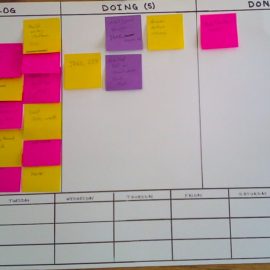

This article gives you a glimpse of what you can learn with Shortform. Shortform has the world’s best guides to 1000+ nonfiction books, plus other resources to help you accelerate your learning.
Want to learn faster and get smarter? Sign up for a free trial here .
What are soft skills? Why is it important to improve soft skills?
Soft skills are character traits and interpersonal skills that help you work well with others. These skills are especially important in the workplace, where social skills and emotional intelligence are highly valued.
Below you’ll learn how to improve soft skills so you can improve your work performance.
What Are Soft Skills and Why Are They Important?
Soft skills are transferable to any field and they’re related to your natural talents and abilities. Most often, hiring recruiters look for soft skills on resumes, so it’s important to develop yours if you’re looking for a new job. Additionally, these skills can help you develop good social habits to use in your professional and personal life.
“Skill” is a commonly misdefined word, even among employers and HR departments. There are three kinds of skills, according to Sidney Fine in What Color Is Your Parachute?:
- Functional (Soft). These skills are things you can do and usually take the form of verbs, for example, singing, teaching, and so on. They’re the basis of any job you take. There are three further categories of soft skills:
- People skills. For example, mentoring and speaking are skills you apply to people.
- Information skills. For example, comparing and synthesizing are skills you apply to information.
- “Thing” skills. For example, operating or setting up inanimate objects are skills you apply to things.
- Knowledge-based. These skills are things you know about and usually take the form of nouns, for example, computer programming, speaking Italian, and so on.
- Traits. These skills are ways you act and usually take the form of adverbs or adjectives, for example, punctual, passionate, and so on.
What Are Your Soft Skills?
Most people don’t know what their soft skills are. If you don’t, do this exercise. Here are the steps:
1. Write seven stories about seven moments in your life. Don’t choose something big like graduating from college; instead, choose a brief moment that you enjoyed. When choosing, consider, for example, stories that: aren’t work-related, demonstrate you acting differently than you normally would, or are difficult, exciting, unusual, or fun. If you really can’t think of anything, describe jobs or roles that you’ve enjoyed. Each story should have:
- A goal.
- For example, you adopted a puppy and wanted to train her as a therapy dog.
- An obstacle you had to overcome.
- The puppy was hard to train.
- The process you used to overcome the obstacle and achieve the goal.
- You researched dog training, signed yourself and the puppy up for a course, and signed up for the certification exam.
- The outcome.
- The puppy passed the exam and started working as a therapy dog at the children’s hospital.
- A statement about the outcome.
- You learned a lot about dog training and love that you did something to help sick children.
2. Carefully reread each story and figure out what soft skills you used in each to achieve your goals. For example, in the puppy story, you used some of the following skills: train, research, and solve problems.
3. Look for a pattern in which soft skills keep recurring. Assuming that you followed the guideline to write stories about truly enjoyable moments, these are your favorite skills because you keep using them.
- For example, some people-related skills you might have employed are to: heal, instruct, counsel, communicate, or serve.
- Some information-related skills you might have employed are to: imagine, analyze, research, problem-solve, or compare.
- Some thing-related skills you might have employed are to: repair, drive, manufacture, restore, or carve.
4. Prioritize soft skills. Narrow the list down to your ten favorite skills (the ones you like exercising, not the ones you think will be most useful). Then, use the prioritizing grid to put them in order of importance.
5. Qualify soft skills with traits and objects. Create a list of your strongest traits. Remember that traits describe how you do things, for example, how you communicate. (To come up with the list, you can take a Myers-Briggs test, or take a Values-in-Action assessment.) Then, combine your traits and skills and add an object if necessary. For example, if the skill is “communicate,” you might specify that you can “communicate authoritatively with children.” These phrases will be your go-to during job interviews.
- Expressing your traits as adverbs (like “authoritatively”) makes it easier to combine your qualities and skills into a single phrase (like “communicate authoritatively”). Some examples of traits in the form of adverbs are: energetically, tactfully, objectively, punctually, and versatilely.
Now we’ll look at how to improve soft skills that you probably need every day: problem-solving, teamwork, time management, adaptability, and communication.
Problem-Solving
Good problem-solving distinguishes a beginner from a master businessperson and is key to success in business and life. In Your Next Five Moves, Patrick Bet-David defines good problem-solving as the ability to think through all options, envision possible consequences of every option, and make beneficial choices based on sound information. The better you become at solving problems, the more success you’ll find because you’ll start thinking of ways to prevent problems.
To solve a problem, see yourself as an active agent in it, stresses Bet-David. Consider how you might have contributed to the problem and take ownership of the solution. This allows you to learn from mistakes and improve as a result of them.
How to Solve Problems Effectively
Let’s now turn to the two parts of effective problem-solving:
Part 1: Identify the Core Problem
First, identify the core problem you’re trying to solve, says Bet-David. Often, the problem you think you need to solve is merely a symptom of a deeper, hidden problem. You need to figure out what the true problem is to effectively solve it.
Identify your core problems by asking “why” questions about the problem until you can’t distinguish a further cause for it—this is the core problem. For example, you might note that you’re receiving complaints about your customer service. Why? Because the department is understaffed. Why? Because customer service agents take lots of time off. Why? Because they aren’t happy with their hours and benefits. Why? Because they need more stable hours and better benefits to have a sustainable lifestyle. You’ve thus identified the core problem.
Part 2: Solve the Problem With Cost-Benefit Analysis
The second part of problem-solving is to devise three possible solutions to the problem you’ve identified and calculate the investment cost, time cost, and benefits each solution offers, writes Bet-David. Then, compare the calculated costs and benefits of each solution and pick the one that offers the most benefits for the lowest cost.
Teamwork
Collaborating with another person (what Stephen R. Covey calls creating “synergy” in The 7 Habits of Highly Effective People) enables you to achieve more than either of you could alone.
According to Covey, collaboration creates an outcome that’s greater than the sum of its parts, as in 1+1 = 3 or more (for example, the harmony of two people singing together is entirely different than any sound either could produce alone). This is possible because the relationship itself adds value by creating the opportunity for collaboration.
Covey says you can’t create this kind of collaborative magic without these interdependent habits:
- Seeking mutually beneficial solutions is a collaborative practice.
- Empathic listening enables you to understand others’ contributions to incorporate and build on them.
These habits foster trust and goodwill, which enables both parties to communicate openly, and that makes collaboration possible. You need a high level of trust and candid communication to produce creative, collaborative results. The collaboration then further strengthens the relationship, which adds to the high levels of trust and encourages even more communication and cooperation.
How to Create Synergy
Before you can effectively collaborate with others, Covey says you need to improve the soft skill “internal synergy,” which we’ll call balance. Life can be logical as well as emotional, and to be effective, you need to be both analytical and intuitive.
Like much of Covey’s advice, collaboration as a concept is fairly simple, but it’s not easy to do. You and the other party may have to overcome substantial challenges to effectively collaborate—but the results are worth the effort.
- Some people especially struggle to adopt a collaborative mindset. Many people become defensive and distrustful when asked to collaborate, so they seldom have successful experiences, which reinforces their skepticism. Often, they see glimpses of collaboration only under extreme circumstances, like an emergency, which can make them believe that collaboration is a rare phenomenon.
- People’s differences are invaluable for collaboration. Differences of opinion make collaboration difficult, but they are essential to the nature of collaboration: Someone who has the same view and opinion as you adds nothing to your knowledge and perspective, but someone with a different view allows you to expand your perspective and come up with solutions that would never have occurred to you. You need to be aware of your own perspectives to recognize that your view of the world is not objective and that others’ views could help you develop a more well-rounded understanding.
- If you can topple the hurdles, the payoff is exponential because collaboration is contagious. If one person is courageous enough to trust those around them and communicate openly, it makes others feel safe to be open and authentic, too. This can create an upward cycle of creativity and collaboration; for instance, in a group brainstorming session, it takes just one out-of-the-box suggestion to lead the group to even more innovative ideas.
Time Management
Significant changes to daily life in the last half-century have overloaded people with work and personal responsibilities, so people need a more dynamic way of managing it all. Thankfully, Getting Things Done by David Allen explains why time management is necessary and how to improve this soft skill by implementing it into your daily routine.
First, most people’s jobs are no longer restricted to the hours of 9 am to 5 pm or the confines of the office. These days, people are always on call via phone and email, and the effects of globalization mean you could be working with people nine time zones away. There are no boundaries to your workday, so it easily steals time from other parts of your life.
Second, the nature of work has changed from more industrial, assembly-line type work with precise, visible tasks to so-called knowledge work with much more ambiguously defined projects. Previously, you knew what your task was (for example, assembling these parts) and you knew when it was done. Now, one task can eat up a lot of your time because there’s no clear signal when you’re done.
Third, modern life requires near-constant communication with more people. Most organizations require increasing interdepartmental collaboration, so workers are no longer limited to their specifically defined roles and departments. In your personal life, too, there’s more pressure to stay connected with friends and family via the Internet and social media.
People have no clear boundaries to work and personal commitments, leaving them with little to no free time—or making them feel guilty or pulled in other directions when they carve out free time.
Established time management tools were developed to organize life the way it used to be.
- Calendars are only effective at organizing a portion of your life.
- To-do lists and prioritizing strategies can’t keep up with the high volume and wide range of tasks most people have.
You need a system that can accommodate today’s faster pace of life and the information that comes from all directions. A modern organization system needs to incorporate minuscule daily tasks as well as big-picture goals, and it needs to be simple enough to save more time and energy than it requires.
How to Use Your Time Wisely
There are two ways to manage your commitments and actions:
- Take stock of your projects and tasks in all areas of your life—from getting your car repaired to finishing a report for work. This requires an organized system that can keep track of everything, helps you call up relevant reminders and information when you need it, and lets you switch your focus quickly and easily.
- Go into the details of one specific project or topic. This might be all the details, research, and planning you need to do for a work report or home addition. This requires a system that lets you organize and easily access plans, notes, and reminders about this one topic.
Manage Your Actions
Most to-do lists are made up of “stuff”—plans and commitments that you haven’t yet broken down into actionable steps. Lists full of stuff are ineffective and overwhelming.
An effective productivity system doesn’t manage your time, information, or priorities; it manages your actions. You can learn how to improve the soft skill of time management by using three objectives:
- Have a trusted external system (outside your memory) to capture everything you must do, might need to do, or might need later.
- Be decisive about all your tasks and commitments and have a running to-do list of the next actions.
- Organize all of the information and to-dos into appropriate categories and contexts.
When you have an organized external system of actionable items and trusted reminders, your brain doesn’t have to juggle all these thoughts and information—which is good because your brain doesn’t do a great job of it anyway.
Manage Your Commitments
The source of many people’s stress is having too many internal commitments or not managing them effectively. These commitments can be as big as hiring a new employee or as small as replacing a lightbulb—anything that’s floating around your mind and nagging at you.
These are called “open loops.” Open loops pull your attention away from the task at hand and need to be addressed to get them off your mind. But you don’t have to actually complete the task to get it off your mind. You just need to take these steps:
- Capture it in an external system called a collection tool, and regularly sort through the system.
- Clarify exactly what you want to accomplish and what you need to do (next actions) to make progress on it.
- Set up reminders to take the actionable steps you’ve identified.
Even though you haven’t actually taken any steps to complete the task, these simple steps make you feel more in control because you engage your mind in how to resolve the problem rather than just thinking about the problem.
Adaptability
You typically live by either a fixed mindset or a growth mindset, which shapes how you learn, cope with setbacks, and relate to others. We’ll look at a comparison of the two mindsets that are described in Carol S. Dweck’s book Mindset to improve soft skills. It’s important to know that even if you have a fixed mindset now, you can learn the growth mindset, which can transform many aspects of your life.
Problem: Fixed Mindset
When you have a fixed mindset, you believe your abilities are unchangeable. You were born with certain traits and a certain amount of intelligence and that’s that. Many people are trained in this mindset from an early age—for instance, by a teacher who believed your IQ determines everything: You’re either smart or you’re not; you can learn or you can’t.
When you view your abilities as unchangeable, you feel you must constantly prove yourself. If people get only a set amount of intelligence and a certain character, you want to prove you have a lot, although you secretly worry you were shortchanged. You don’t want to look stupid or fail. You feel you’re being judged or rated in every situation and must measure up. Children inculcated with this mindset often fear losing their parents’ or teachers’ approval and love if they fail.
Solution: Growth Mindset
Having a growth mindset is the perfect way to improve this soft skill. When you have a growth mindset, you believe the abilities you’re born with are a starting point you can build on with hard work, persistence, and the right learning strategies. You have a passion for learning, welcome mistakes as opportunities to learn, and seek challenges so you can stretch. You also have a greater ability to survive difficult times.
The author first encountered the growth mindset as a young researcher while studying how children coped with failure. She gave kids a series of puzzles to solve, progressing from easy to difficult ones. She was surprised to find that some children loved attempting the hard puzzles, relishing the challenge and opportunity to become smarter. Until then, the author had viewed intelligence and problem-solving as fixed abilities, but watching kids learn from failure changed her mind.
Believing in the ability to learn and grow doesn’t mean believing anyone can become an Einstein or believing anyone can do anything they aspire to if they apply enough effort. But the growth mindset recognizes that you can’t predict someone’s potential or how far their passion, work, and learning can take them.
Change Your Mindset: Tips
Try these tips to improve your soft skills and embrace a growth mindset:
- A fixed mindset can undercut your enjoyment of learning. Did you ever enjoy something for a while and then want to quit when it started to seem more difficult? You were probably in a fixed mindset. Create a growth mindset by imagining your brain growing by forming new connections as you keep learning.
- If a past failure keeps bothering you, try rethinking it from a growth perspective. Think about what you can learn from the situation and how you can grow.
- It feels great to be around people who think we’re perfect, or who don’t question or criticize us. Many of us would rather avoid negative feedback — but allow yourself to grow by asking someone for constructive criticism.
- Do you give up and withdraw when you feel depressed? Next time, try to put yourself in a growth mindset by doubling down when things are difficult. View effort as an asset.
Adapting to Different Personalities
Changing your mindset also means adapting to different personality types. You won’t always be able to work with like-minded people and will have to learn how to deal with them. Surrounded by Idiots by Thomas Erikson explains, color-by-color, how to adapt to, persuade, and work with other personality types.
How to Persuade a Red Personality: Focus on the future and take initiative. Erikson says people with Red personalities are always looking to the future, and they respect people who take initiative instead of waiting for directions. Tell them exactly what you plan to do to help them. Use concrete figures and stay away from flowery language.
How to Work With a Red Personality: Help manage the details. Though they won’t like it, you can help this personality type by reminding them that details are, in fact, important. You might offer to take up the minutiae yourself, or suggest they delegate those tasks to a teammate who will thrive.
How to Persuade a Yellow Personality: Highlight the innovation. Yellow personalities love being the first to experience something, so Erikson says if you want to sell them something, you should point out the features that are new and exciting.
How to Work With a Yellow Personality: Create structure. If you want to help a teammate with this personality, Erikson recommends you offer to create some structure by writing up the to-do lists or managing the schedule. They will appreciate someone else taking on this task, and you’ll probably be better at it too.
How to Persuade a Green Personality: Narrow down the choices. Whatever you’re trying to sell to someone with this personality type, Erikson recommends you come to the table with one or two options. Do the research and planning ahead of time, then explain how you narrowed the choices; she will appreciate it.
How to Work With a Green Personality: Take charge. Green personality types rarely want to lead, and they aren’t built for it. If you’re working with someone with this personality, Erikson recommends you lead the conversations and make the major decisions. Greens prefer to follow the roadmap rather than write it.
How to Persuade a Blue Personality: Over-prepare. When you want to persuade this personality type, be more prepared than you think you need to be. Erikson recommends you predict what they will ask and have documentation ready. If you don’t know the answer, Erikson warns against guessing.
How to Work With a Blue Personality: Allow her to be meticulous, even if it takes a long time. When it comes to work, Erikson says Blue personalities value quality over everything else. Although they may take longer than you’d like, Erikson says you’ll save time in the long run because corrections won’t be needed.
Effective Communication
In The Culture Map, Erin Meyer says that language is one factor that shapes someone’s communication style. Learning how to communicate effectively is essential for good business. But contrary to popular belief, the techniques for good communication vary depending on the place you’re in. Meyer refers to these places as “higher-context cultures” and “lower-context cultures.”
Meyer defines low-context cultures as cultures where people communicate and receive messages at face value. The speaker explicitly states all relevant information because it’s her responsibility to communicate her message clearly. In contrast, high-context cultures don’t communicate at face value—rather, you read between the lines. These people share cultural understandings about etiquette, so the speaker doesn’t need to be explicit; the listener is responsible for decoding the underlying meaning.
When the Person Is From a Higher-Context Culture Than Yours
Listen more. As you listen, Meyer recommends focusing on interpreting the subtext of what your conversation partner is saying. And don’t repeat yourself! This can come across as unnecessarily condescending, according to Meyer.
Pay attention to the other person’s body language.
Ask more questions. Specifically, ask open-ended questions to clarify your understanding of what is being said. Meyer urges persisting until you’re sure about the meaning.
Assume the best in others. Remember, people from higher-context cultures are (most likely) not trying to manipulate you. You may be tempted to think they’re bad communicators. But their communication style works in their culture. It just doesn’t work in yours.
Explain why you’re writing things down. People in high-context cultures can interpret the act of writing things down as a sign you don’t trust them. Meyer suggests explaining that it’s a cultural difference. This will help ease any potential misunderstandings.
Ask for help. Meyer suggests explaining that you’re having trouble with the cultural difference and asking for help. This might come easier if you combine it with complimenting the other culture and making jokes at your own expense.
When the Person Is From a Lower-Context Culture Than Yours
Be clear and specific. Follow the English maxim “say what you mean, and mean what you say.”
Ask questions. When you don’t understand what someone’s saying, don’t look for subtext in your conversation. Just ask! Meyer also recommends asking questions to determine whether your counterpart has understood your message, such as “Am I being clear enough?”
Recap what was said, and follow up. People in lower-context cultures tend to write things down to ensure that ideas and processes remain transparent. Meyer recommends following this process: Review the content of the conversation, the action steps, and who’s responsible for each action step at the end of each conversation or meeting. You should also send a follow-up email with the same content to keep everybody informed. In this email, clarify any points you think the other person might have misunderstood during your conversation.
When You’re Dealing With Members From Two Different High-Context Cultures
According to Meyer, the biggest potential for miscommunication lies between two people from different high-context cultures. This is because both are looking for subtext, but the cultural norms by which that subtext is informed differ drastically.
Meyer states that you need a low-context communication method for your team to be successful. For it to be as successful as possible, follow these principles.
#1: Create a low-context process first. Clearly articulating the communication method before you start doing any work is the most effective way to prevent potential misunderstandings. The goal is to be as explicit as possible on multiple levels to prevent misunderstanding.
#2: Let the team create the communication process.
Final Words
There are many other soft skills that you can develop, but the five listed above are essential. Whether you’re looking to improve your soft skills for a greater business opportunity or to live a worry-free life, these skills will set you up for success.
Did we miss any ways to improve soft skills? If so, leave your suggestions in the comments below!

Want to fast-track your learning? With Shortform, you’ll gain insights you won't find anywhere else .
Here's what you’ll get when you sign up for Shortform :
- Complicated ideas explained in simple and concise ways
- Smart analysis that connects what you’re reading to other key concepts
- Writing with zero fluff because we know how important your time is






